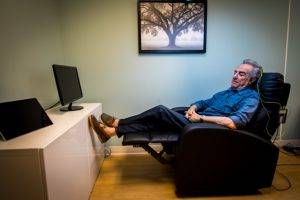What does this mean?
We use NeurOptimal® Dynamical Neurofeedback
Dynamical Neurofeedback® is a technology developed by Zengar Institute and used in its NeurOptimal® neurofeedback training systems.
Instead of providing specific “direction”, Dynamical Neurofeedback® is designed to take advantage of the brain’s natural learning processes by encouraging it to function as originally designed. NeurOptimal®’s neurofeedback trainers then simply promote and facilitate the brain’s natural tendency toward self-regulation, resilience and flexibility.
The Dynamical Neurofeedback® technology is unique to the NeurOptimal® Trainer interface and is based on the following observations regarding brain physiology:
Brain Dynamics
The brain is a dynamical organ geared towards general, but not absolute self-regulation. No one needs to teach a young child the “best” way to walk. Through experimentation, the brain discovers and develops an internal balance and natural gait unique to that individual. The twin processes of adaptation and accommodation work as a dynamic pair to establish the individually unique and optimal way for each individual to work, given their overall physical status, including any limitations or constraints.
This happens because the brain is continually processing and assessing feedback from the muscles and other aspects of the musculo-skeletal system about their relative position and stability in space. In this way it explores, extends and consolidates the intrinsic resilience and flexibility required to walk adaptively regardless of the surface and how soft, bumpy, stable or slippery, etc it might be. Repeating this process throughout each step enables the brain to learn how to walk — all without any “expert” explaining which movements of which muscles are necessary.
Similarly, Dynamical Neurofeedback® allows the brain to assemble its own response and coping strategies based on incoming information. As a result, the NeurOptimal® system is intrinsically non-invasive and non-corrective.
Process Variability
In addition to infinitely cycling and self-regulating, the brain does not possess absolute values for how much of any particular brain wave is inherently “best” for certain activities. Any such “average” significantly varies from person to person and moment to moment throughout the day. This amount depends on many factors: the task in which the person is engaged; time of day, blood sugar levels; recent amount of rest and sleep, overall health, etc.
Given these multiple variables, Dynamical Neurofeedback® does not attempt to restore brain waves to some presumed “average” or “best” level. Instead. NeurOptimal® simply provides the central nervous system with information about what it has already done and allows the brain itself sort out the value of that information. Harnessing the brain’s intrinsic intelligence to regulate the amount of brain waves necessary in any specific moment for that individual is infinitely more effective than turning the task over to even the most powerful computer processor.
Functional Targeting
Given that dynamical, non-linear nature of the brain’s physiological functions, designing a neurofeedback system to target specific conditions or complaints would be akin to chasing sand grains in a desert storm. Dropping a pin in one point in time to address one function or another will ultimately miss the mark because the brain has already “moved on”.
Instead, Dynamical Neorofeedback® is designed to monitor the brain’s electrical activity and – through audible feedback interruptions – notify the brain when it is about to reach the edge of its stability in some region of function. There is nothing intrinsically problematic in reaching the edge of stability. It is precisely what happens when someone goes to sleep. The transition from wakeful consciousness to sleep occurs through a turbulent transition that is marked by the sudden onset of stability: wakefulness collapses as sleepiness emerges and then transitions rapidly into light sleep.
Though essential at least once every 24 hours, this natural transition into sleep would be problematic if it occurred while driving in rush hour. The NeurOptimal® system provides a signal, or feedback, to alert the brain that such a transition between states is about to occur. This notification prompts the brain to determine if the transition is desirable or problematic given the current conditions.
Dynamical Neurofeedback®, then, allows the brain to reconnect with its own internal resources to determine what is appropriate in various situations and how best to cope with this information. It is the NeurOptimal® system’s permeability with the brain’s natural processes that allows Dynamical Neurofeedback® to produce such positive effects for so many people regardless of what particular concerns prompted the neurofeedback training. Instead of “chasing problems”, the NeurOptimal® system simply prompts the brain to source its own internal, information-rich way of approaching the world across all situations. This non-invasive prompting encourages the brain to return to far more efficient and effective operation regardless of internal and external challenges and demands. As a result, symptoms and problems simply drop away, seamlessly for most people.









